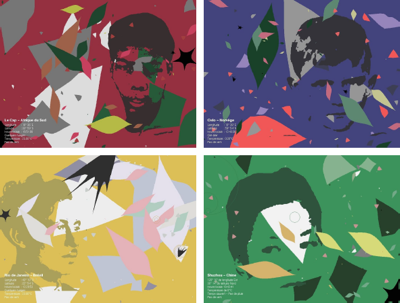
|
Mutations
Plastic and musical numeric installation © B. Gortais/Y. Orlarey/G. Hutzler |
:: Credits ::
- Bernard Gortais (scenography and plastic design)
- Guillaume Hutzler (technical design and programming)
- Yann Orlarey (musical design and programming)
:: Exhibitions ::
- March 10th-19th 2000: Musiques en Scène contemporary music festival, Lyon Cité Sonore, Grame, Lyon (France)
- December 7th-10th 2000: Les Nouveaux Gutenberg, Morlaix (France)
- April 3rd-June 9th 2001: Art et technologie festival, espace Jean Legendre, Compiègne (France)
- March 28th-May 1st 2001: Traverser un jardin silencieux, Bernard Gortais personal exhibition, Abbaye des Prémontrés, Pont-à-Mousson (France)
- September 26th-October 4th 2003: Arborescence Contemporary art festival, Aix-en-Provence
- October 13th-18th 2009: La Novela, festival des savoirs, Toulouse (France)
:: Publications ::
In English
 Hutzler G., Gortais B., Orlarey
Y., "Mutations: Plastic and Musical Improvisation by
Distributed Agents", in World Multiconference on Systemics,
Cybernetics and Informatics 2001, Orlando (Florida, USA),
N. Callaos, X. Zong, C. Vergez and J. R. Peleaz eds, Volume
X, pp. 380 385, IIIS, Orlando, 2001.
Hutzler G., Gortais B., Orlarey
Y., "Mutations: Plastic and Musical Improvisation by
Distributed Agents", in World Multiconference on Systemics,
Cybernetics and Informatics 2001, Orlando (Florida, USA),
N. Callaos, X. Zong, C. Vergez and J. R. Peleaz eds, Volume
X, pp. 380 385, IIIS, Orlando, 2001.
 Hutzler G.,
Gortais B., Drogoul A., "The Garden of Chances: a Visual
Ecosystem", in Leonardo, Vol. 33, Issue 2, pp. 101-106,
April 2000, International Society for the Arts, Sciences and
Technology, MIT Press.
Hutzler G.,
Gortais B., Drogoul A., "The Garden of Chances: a Visual
Ecosystem", in Leonardo, Vol. 33, Issue 2, pp. 101-106,
April 2000, International Society for the Arts, Sciences and
Technology, MIT Press.
In French
 Hutzler G., "Le Has(Art) et la
néce(Cité) - Une approche (auto-)poïétique des systèmes
complexes", Thèse d'Habilitation à Diriger des Recherches,
Université d'Evry-Val d'Essonne, 15 juin 2011.
Hutzler G., "Le Has(Art) et la
néce(Cité) - Une approche (auto-)poïétique des systèmes
complexes", Thèse d'Habilitation à Diriger des Recherches,
Université d'Evry-Val d'Essonne, 15 juin 2011.
 Hutzler G., "Le Has(art) et la
nécessité", Esthétique et Complexité - Créations,
expérimentations et neurosciences, Z. Kapoula et
L.-J. Lestocart éds., pp. 85-102, Editions du CNRS, Paris,
2011.
Hutzler G., "Le Has(art) et la
nécessité", Esthétique et Complexité - Créations,
expérimentations et neurosciences, Z. Kapoula et
L.-J. Lestocart éds., pp. 85-102, Editions du CNRS, Paris,
2011.
:: Presentation ::
A sound ecosystem
In this project, created in collaboration with Y. Orlarey of Grame (Hutzler et al. 2001), the focus was on sound dynamics alongside visual dynamics. The main idea was to enable the agents making up the image to "sing" according to their individual "state of form", and according to their mutual interactions. The aim is to establish musical dialogues between neighboring shapes in the image and, more generally, a musical composition at system level. At a higher level, the project is to link four distinct systems, connected to four sources of meteorological data corresponding to four geographical locations symbolizing the four seasons (Capetown, Oslo, Shuzhou, Rio de Janeiro). The aim is to fully immerse the viewer in an ever-changing visual and aural ambience, with strong contrasts in both visual and aural terms.Has(art) and necessity
To avoid cacophony, the agents' "voices" need to harmonize, and not all agents need to sing simultaneously. The first aspect has been addressed by associating sampled sound files with the agents, created and selected to form a coherent sound palette for each system. The second aspect is addressed by considering that agents, as they evolve in the ecosystem, acquire a greater or lesser amount of energy. Those whose energy exceeds a high Sh threshold can then spontaneously sing (see below), propagating a sound wave around them. Agents that perceive a sound wave can in turn sing, provided their energy exceeds a low threshold Sb (see below). The intensity of singing is proportional to the energy of the agent producing it. Singing is also accompanied by a decrease in energy, so as to prevent two neighboring agents from activating each other infinitely.